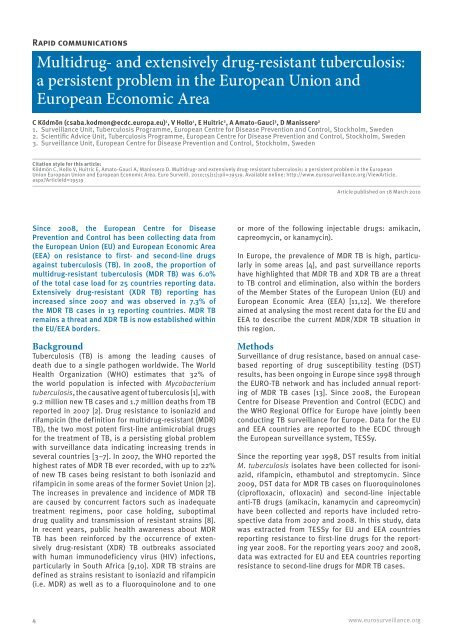Tuberculosis - Eurosurveillance
Tuberculosis - Eurosurveillance
Tuberculosis - Eurosurveillance
You also want an ePaper? Increase the reach of your titles
YUMPU automatically turns print PDFs into web optimized ePapers that Google loves.
Rapid communications<br />
Multidrug- and extensively drug-resistant tuberculosis:<br />
a persistent problem in the European Union and<br />
European Economic Area<br />
C Ködmön (csaba.kodmon@ecdc.europa.eu) 1 , V Hollo 1 , E Huitric 2 , A Amato-Gauci 3 , D Manissero 2<br />
1. Surveillance Unit, <strong>Tuberculosis</strong> Programme, European Centre for Disease Prevention and Control, Stockholm, Sweden<br />
2. Scientific Advice Unit, <strong>Tuberculosis</strong> Programme, European Centre for Disease Prevention and Control, Stockholm, Sweden<br />
3. Surveillance Unit, European Centre for Disease Prevention and Control, Stockholm, Sweden<br />
Citation style for this article:<br />
Ködmön C, Hollo V, Huitric E, Amato-Gauci A, Manissero D. Multidrug- and extensively drug-resistant tuberculosis: a persistent problem in the European<br />
Union European Union and European Economic Area. Euro Surveill. 2010;15(11):pii=19519. Available online: http://www.eurosurveillance.org/ViewArticle.<br />
aspx?ArticleId=19519<br />
Since 2008, the European Centre for Disease<br />
Prevention and Control has been collecting data from<br />
the European Union (EU) and European Economic Area<br />
(EEA) on resistance to first- and second-line drugs<br />
against tuberculosis (TB). In 2008, the proportion of<br />
multidrug-resistant tuberculosis (MDR TB) was 6.0%<br />
of the total case load for 25 countries reporting data.<br />
Extensively drug-resistant (XDR TB) reporting has<br />
increased since 2007 and was observed in 7.3% of<br />
the MDR TB cases in 13 reporting countries. MDR TB<br />
remains a threat and XDR TB is now established within<br />
the EU/EEA borders.<br />
Background<br />
<strong>Tuberculosis</strong> (TB) is among the leading causes of<br />
death due to a single pathogen worldwide. The World<br />
Health Organization (WHO) estimates that 32% of<br />
the world population is infected with Mycobacterium<br />
tuberculosis, the causative agent of tuberculosis [1], with<br />
9.2 million new TB cases and 1.7 million deaths from TB<br />
reported in 2007 [2]. Drug resistance to isoniazid and<br />
rifampicin (the definition for multidrug-resistant (MDR)<br />
TB), the two most potent first-line antimicrobial drugs<br />
for the treatment of TB, is a persisting global problem<br />
with surveillance data indicating increasing trends in<br />
several countries [3–7]. In 2007, the WHO reported the<br />
highest rates of MDR TB ever recorded, with up to 22%<br />
of new TB cases being resistant to both isoniazid and<br />
rifampicin in some areas of the former Soviet Union [2].<br />
The increases in prevalence and incidence of MDR TB<br />
are caused by concurrent factors such as inadequate<br />
treatment regimens, poor case holding, suboptimal<br />
drug quality and transmission of resistant strains [8].<br />
In recent years, public health awareness about MDR<br />
TB has been reinforced by the occurrence of extensively<br />
drug-resistant (XDR) TB outbreaks associated<br />
with human immunodeficiency virus (HIV) infections,<br />
particularly in South Africa [9,10]. XDR TB strains are<br />
defined as strains resistant to isoniazid and rifampicin<br />
(i.e. MDR) as well as to a fluoroquinolone and to one<br />
Article published on 18 March 2010<br />
or more of the following injectable drugs: amikacin,<br />
capreomycin, or kanamycin).<br />
In Europe, the prevalence of MDR TB is high, particularly<br />
in some areas [4], and past surveillance reports<br />
have highlighted that MDR TB and XDR TB are a threat<br />
to TB control and elimination, also within the borders<br />
of the Member States of the European Union (EU) and<br />
European Economic Area (EEA) [11,12]. We therefore<br />
aimed at analysing the most recent data for the EU and<br />
EEA to describe the current MDR/XDR TB situation in<br />
this region.<br />
Methods<br />
Surveillance of drug resistance, based on annual casebased<br />
reporting of drug susceptibility testing (DST)<br />
results, has been ongoing in Europe since 1998 through<br />
the EURO-TB network and has included annual reporting<br />
of MDR TB cases [13]. Since 2008, the European<br />
Centre for Disease Prevention and Control (ECDC) and<br />
the WHO Regional Office for Europe have jointly been<br />
conducting TB surveillance for Europe. Data for the EU<br />
and EEA countries are reported to the ECDC through<br />
the European surveillance system, TESSy.<br />
Since the reporting year 1998, DST results from initial<br />
M. tuberculosis isolates have been collected for isoniazid,<br />
rifampicin, ethambutol and streptomycin. Since<br />
2009, DST data for MDR TB cases on fluoroquinolones<br />
(ciprofloxacin, ofloxacin) and second-line injectable<br />
anti-TB drugs (amikacin, kanamycin and capreomycin)<br />
have been collected and reports have included retrospective<br />
data from 2007 and 2008. In this study, data<br />
was extracted from TESSy for EU and EEA countries<br />
reporting resistance to first-line drugs for the reporting<br />
year 2008. For the reporting years 2007 and 2008,<br />
data was extracted for EU and EEA countries reporting<br />
resistance to second-line drugs for MDR TB cases.<br />
4 www.eurosurveillance.org
















